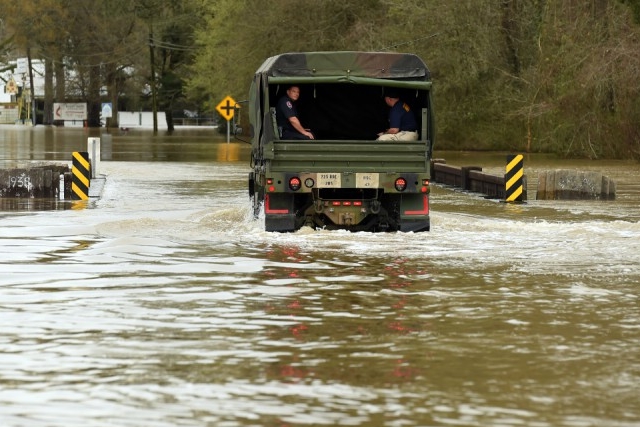
Louisiana National Guard troops help residents in areas hit by recent floods in that state. (Louisiana National Guard)
18 July 2019. A set of computational tools developed at Purdue University enables public safety agencies to monitor potentially catastrophic events in real time by analyzing text and images on social media. The technologies behind the Social Media Analytics and Reporting Toolkit, or SMART, are also being commercialized by Davista Technologies, a spin-off enterprise from the university, marketing data visualization systems to help the work of emergency management agencies.
The SMART package offers public safety managers a way to organize, process, and visualize the mass of unstructured information that erupts when emergencies happen, to identify people needing help. Much of those data originate in social media messages and interactions posted by individuals describing their current circumstances, environments, and locations. The system analyzes the data from several angles simultaneously, then creates visualizations for users to quickly identify the location and scale of problems.
SMART monitors social media channels, such as Twitter and Instagram, and extracts trending topics or anomalies from the posts. Messages and terms in posts are filtered and put into context, such as severe weather occurring in the locations where the messages are occurring. Machine learning algorithms also evaluate these messages in their contexts to validate the likelihood of real emergencies, such as floods or medical crises. The data then are converted into visual form, including on maps. A key part of SMART called TopoText that visualizes aggregated text data on multiple dimensions in a single display was described at last year’s annual ACM conference on human factors in computing systems in Montreal.
David Ebert, professor of electrical and computer engineering at Purdue and director of the research center that developed SMART, says the system is beginning field tests at local agencies. “We have launched a pilot program with a dozen of agencies across the country,” says Ebert in a university statement. “They are taking our platform and using it in their command centers to monitor big events, disasters and other public safety concerns.”
The research center known as the Visual Analytics for Command, Control, and Interoperability Environments, or Vaccine, is funded by the U.S. Department of Homeland Security, which financed as well the SMART package. DHS is also supporting the roll-out of SMART to local public safety agencies.
Ebert filed for a patent on the SMART technology, and co-founded Davista Technologies LLC in West Lafayette, Indiana to take the technologies to market. The company develops systems that visualize risk profiles and vulnerabilities, but also help plan security guard deployments and placement of surveillance video cameras. Abish Malik, Ebert’s engineering colleague at Purdue is Davista’s co-founder and the company’s chief technology officer.
More from Science & Enterprise:
- A.I., Robotics Deployed for Harvesting Lettuce
- Infographic – Technology Transforms Manufacturing
- A.I. Chip Start-Up Raises $23M in Early Funds
- MIT, Air Force to Open A.I. Accelerator Lab
- Infographic – Americans Leery of Biometrics
* * *

 RSS - Posts
RSS - Posts
You must be logged in to post a comment.